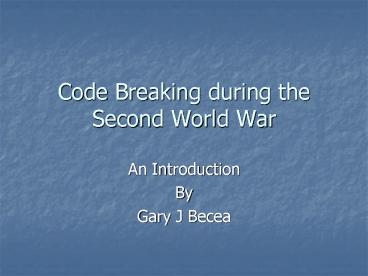Code Breaking during the Second World War - PowerPoint PPT Presentation
1 / 22
Title:
Code Breaking during the Second World War
Description:
Code Breaking during the Second World War An Introduction By Gary J Becea Communications In Warfare Wireless radio caused a revolution in Military Communications ... – PowerPoint PPT presentation
Number of Views:497
Avg rating:3.0/5.0
Title: Code Breaking during the Second World War
1
Code Breaking during the Second World War
- An Introduction
- By
- Gary J Becea
2
Communications In Warfare
- Wireless radio caused a revolution in Military
Communications - Leaders could communicate with units
instantaneously and vice versa. - Wireless radio ended the need to lay or string up
wire thus saving time and equipment.
3
Communications during WWI
- Wireless was used during World War One
- The effect was minimal due to the greater
destructive power of weapons which resulted in a
general stalemate on the Western Front. - Codes were developed to keep combatants from
listening in on each others plans and
communications. - Codes were routinely broken.
4
Codes and machines developed in the interwar
period
- The need for better ways to secure codes was
clear. - Dutch Naval officers began work on a machine to
encrypt messages. - The Germans acquired the patent in 1918.
- A military model was adopted in 1926.
- This machine was known as the Enigma.
5
The Enigma
- The enigma machine was a typewriter device.
- The Enigma used rotors that were set to a
combination which encrypted a plain text message
to a pattern of letters. - It could be set many different ways.
6
The Enigma
- Thus there were numerous combinations that could
be set. - Letters would be encrypted to different letters
and not always the same letter. - The message recipient merely set the rotors in
the same combination as the sender and deciphered
the message by typing in the code. - The Germans thought this machine to be
undecipherable by merely ensuring the security of
the rotor settings combinations.
7
However, the British had a plan.
8
The Code Breakers
- Polish scientists began studying the Enigma
before the war. - They contacted the British and a special
operation was set up at Bletchley Park, a manor
in Britain. - An incredible collection of scientists,
mathematicians, and even crossword puzzle experts
were assembled to break the Enigma code.
9
The Code Breakers
- The Code Breakers got to work and were able to
break the codes. - It was not easy and took constant effort.
- They developed many machines that helped decrypt
messages including one of the worlds first
computers.
10
The effects
- The operation at Bletchley Park began to have a
positive effect. - In North Africa and especially in the Battle of
the Atlantic.
11
The Battle of the Atlantic
- The U-Boat menace in the Atlantic was a primary
focus at Bletchley Park. - Allied shipping losses were high early in the
war. - This threatened Britains ability to carry on the
fight.
12
The Battle of the Atlantic (cont.)
- Enigma components were captured from U-Boats.
- This led to Bletchley Park to be able to decipher
German communications with U-Boats. - Allied forces could then locate U-Boat positions
and reroute convoys.
13
U-Boat losses increased, the red dots indicate
U-Boats sunk.
14
Bletchley Parks contribution to victory.
- Bletchley Parks operations gave the Allies the
ability to decipher German codes at various times
during the War in Europe. - How they did this and how much of an effect it
had is for you to find out. - Happy Hunting!
15
Code Breaking in the Pacific
- Code breaking was also an important part of the
pacific war. - U.S. Naval intelligence was routinely able to
decipher Japanese codes. - This had a dramatic effect.
16
The Battle of Midway
- The most stunning example of U.S. Naval code
breaking resulted in the Battle of Midway. - By deciphering Japanese codes the U.S. Navy were
able to counter a planned attack at Midway Island
in 1942. - The result was a massive victory that was the
turning point of the Pacific War.
17
Another coup for Code Breakers
- In 1943, U.S. naval intelligence intercepted
messages that outlined a tour by the Japanese
Admiral Yamamoto. - He was the commander of the Japanese Navy and an
excellent leader. - The deciphered messages allowed American Air
forces to intercept and shoot down his plane.
18
Conclusion
- The importance of code breaking operations in
World War II is clear to see. - A good place to study this is at
http//www.bbc.co.uk/history/war/wwtwo/enigma_03.s
html. - The end.
19
References
- http//www.history.navy.mil/photos/events/wwii.pac
/midway/midway.htm - http//www.gwpda.org
- http//www.bbc.co.uk/history/war/wwtwo
- http//www.bletchleypark.org.uk
- http//www.alanturing.net
- http//www.uboat.net
- http//www.bletchleypark.net/stationx/
20
Picture Descriptions in order of appearance
- WWI German soldiers cutting wire.
- WWI US radio operators (Field Artillery).
- The Enigma machine.
- Winston Churchill.
- Marian Rejewski.
- Alan Turing.
- Turings Bombe computer.
- Lorenz deciphering machine.
- Field Marshall Montgomery.
21
Pictures cont.
- Destroyer, HMS Hogue.
- Frigate, HMS Barham.
- Tanker.
- U-505.
- U-Boat.
- Map of U-Boat losses in So. Atlantic from
U-Boat.net. - US Coast Guard crew.
- Newspaper headline.
- Japanese carrier Hiryu.
22
Pictures cont.
- Admiral Yamamoto.
- Painting of aerial ambush of Yamamotos plane.
- Bletchley Park mansion.































